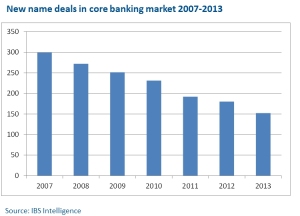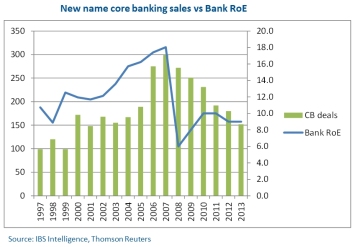In the last two weeks, the results of two annual surveys have been released which, taken together, serve as a barometer of demand conditions and competitive dynamics in the market for large ticket banking applications. In 2013, more than in any other year, the difference between banks’ propensity to spend on core banking systems compared to broader ancillary applications, such as mobile platforms, is stark. Nonetheless, there are many reasons to be optimistic about a pick-up in demand for core systems in 2014.
What gets measured
The two annual surveys are namely the International Banking Systems (IBS) journal’s 2014 Sales League Table, which looks at new name sales across core banking and treasury and capital markets (TCM) in 2013, and the Forrester “Global Banking Platform Deals in 2013”, which examines both new and existing name deals across multiple banking platforms including core banking as well as mobile and analytics.
Demand for core banking hits multi-year low
The IBS league table shows Temenos extended its lead in core banking sales, taking up its market share by four percentage points compared to 2012. As a Temenos employee, this is good news: it shows our strategy, value proposition and execution are all sound and winning out in a competitive market. However, there is an inconvenient fact that punctures any feeling of euphoria: the market has been shrinking over recent years. The graph below, which strips out TCM sales from the IBS data, illustrates the extent to which the market has declined. It has halved since 2007 and experienced its worst year since 2001.
Other banking applications faring much better
In contrast, the Forrester survey, in which Temenos also comes out on top, shows that the overall demand for banking platforms remains strong. While there was a small drop in volume of new name business, this was more than offset by strong growth in sales to existing customers (up by 12%) such that overall sales of banking platforms were up by 4%. Moreover, excluding core banking from the Forrester numbers, new name sales were likely up by around 5% and combined sales by around 10%. It would seem that banks are much happier to spend money in areas like mobile, analytics and CRM than in core banking, presumably because the size, cost and complexity of these projects are more manageable and the payback promises to be shorter (Capgemini estimated in a recent report that the average payback for core banking projects is 4.5 years).
Room for optimism about core banking market
Notwithstanding years of decline, there are many reasons to think that 2014 will see a strong rebound in core banking sales:
- Western Europe is growing again – the IBS league table showed growth in Western Europe in 2013, of 5%. This is a significant datapoint because W. Europe is the largest market for core sales (around a quarter of the total market), it has the largest average deal sizes and it has fallen the furthest since the market peak in 2007 (by around 60% vs 50% for the overall market).
- Large deals are coming back – our estimate is that almost 20% of deal volume was from tier 1 and 2 banks in 2013 (compared to c15% in 2012) and these deals tend to be much larger in scope and value.
- Deal momentum grew all year (38% of deals came in Q4 vs. 30% in Q4 2012)
- Budgets are up – a Temenos/Deloitte survey from last year of 205 senior bankers said that 65% expected a higher IT budget in 2014, the highest reading for six years
- The industry is maturing. This is not a reason to be more bullish about 2014 per se, but the industry has matured significantly over recent years. The implementation record is improving, for instance, as large systems integrators like Accenture build core banking practices. Also, there are now several vendors who have componentised their systems, allowing banks to progressively renovate their IT estates, minimising risk and disruption while delivering continual, demonstrable value to the institutions.
- Banks are unlikely to realise the benefits from mobile and analytics investments without also modernising core systems. The Forrester survey showed banks investing in ancillary systems, but while banks can produce new apps and customer interfaces, if they rely on batch systems for information updates, the analytical capabilities and the information underpinning the customer experience will always sub-optimal
- The industry needs a structural answer to a structural issue. The graph below shows the strong correlation between sales of core banking systems and bank RoE. A pessimist might argue that bank RoE is likely to be only modestly higher in 2014 and thus core banking sales will only see a slight improvement. However, this historical relationship should break down. Why? Because the confluence of various factors – changing customer behaviour, new regulation, new competition, new technology – has reset banking RoE to a materially lower level. In this new environment, it is incumbent on banks to modernise IT to return to more profitable times. This is because banks need to reduce IT spend (which accounts 14.3% of costs vs. a cross- industry average of 7% and a Temenos customer average of 5.4%). But, it is also because banks will require the agility and flexibility that comes from core modernization if they are to see off the threat from non-traditional players and realise the growth opportunities from digitalization.


